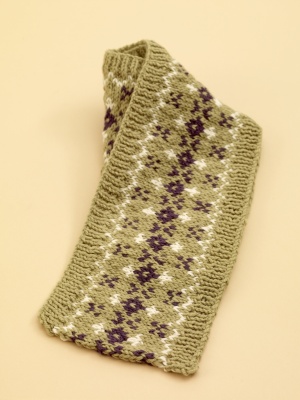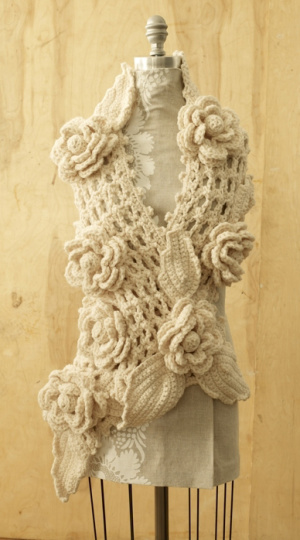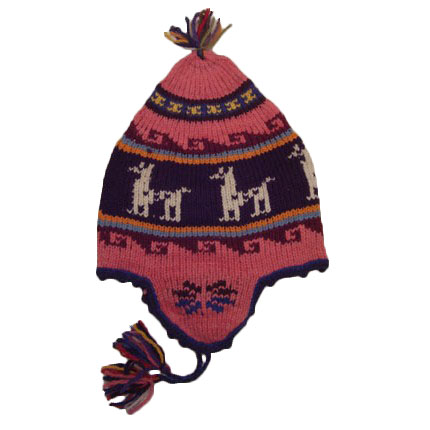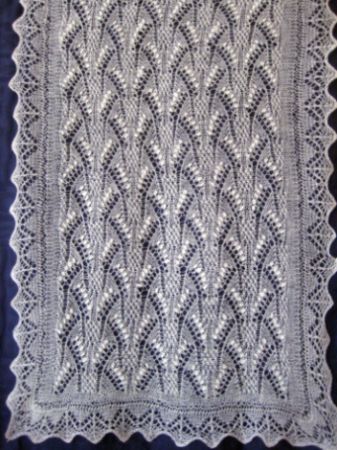For some people, knitting or crocheting might be a hobby, while for others, it has been a cultural influence. Like the United States, the United Kingdom has seen a large increase in knitting popularity over the years; In July, an English newspaper entitled The Guardian, mentioned in their article “Pride in the wool: the rise of knitting“, that knitting searches on Google have increased to over a million per month. Although there has been a recent increase in yarncrafting popularity, in many instances, knitting or crocheting has been passed along from generation to generation; it is common to hear, “My grandmother (mother) taught me when I was a child”. Knitting and crocheting is done all over the world, in many different styles; see the roundup below to check out some knitting styles adapted from over seas!
 |
Fair Isle
Fair Isle knitting is a technique that originated from Fair Isle, a small island located in the Shetland Islands of northern Scotland. The technique is a traditional style that works in the round and uses two colors per row, usually with frequent color changes. This style was developed in the mid 19th century and uses basic knit stitches, no purling. Fair Isle knit patterns became very popular once they were seen on King Edward VIII, who donned the pattern during golfing in the 1920s. Click here to see Lion Brand’s Fair Isle patterns. |
 |
Irish Lace Crochet
Irish lace crochet is a technique that dates back to the 19th century famine years in Ireland. During this time, charity groups taught crochet lace techniques to anyone who was willing to learn; they saw it as a way to jump start the economy. The style is comprised of separately crocheted motifs which are then applied to a mesh background. The tools for Irish lace crochet involve a fine steel crochet hook and thread or cotton in varying weights. A thinner thread/cotton is used for the mesh while a thicker thread/cotton is used for the motifs. Click here to see Lion Brand’s Irish Lace Crochet pattern. |
 photo source: photo source:Original Artisan |
Andean Knitting
The culture of knitting in the Andes is quite interesting because it is done primarily by the men. The men knit caps (also known as Chullos) to keep them warm while working, and are mostly made with natural fibers, such as that from an Alpaca. The ear flaps are an important part of the cap, providing good insulation. These hats are knit with very thin double-pointed needles and incorporate a plethora of colors. Chullos often tell a story of the man who’s wearing it, so a lot of motifs (animal and human), stripes, diagonal lines and diamond patterns can be found on them; the Andean men take a lot of pride in their knitting. Click here for Lion Brand ear flap hat patterns. |
 picture source: Globe Hoppers |
Estonian Lace/Haapsalu shawl
The Estonian lace shawl is a traditional knit style originating from Haapsalu, a small town in Estonia. Local artists sold these shawls at the seaside during the late 19th century, ranking popular amongst the Russian aristocracy for souvenirs and gifts. A traditional shawl is knit as a rectangle, and uses very fine lamb wool yarn- mostly done in white. The shawls are traditionally constructed using wooden needles. The shawl’s body is composed of a center, a border and an edge- which has been knit separately and then sewn to the body. This knitting tradition is still kept alive today through the school systems, as girls are taught this intricate pattern in grade school, and pride themselves on completion. |
I’d love to hear how you learned to knit/crochet; were you taught by family, self taught or took a class? Are any of you familiar with these styles? I’d personally love to be able to Fair Isle knit one day, but since I’m still a beginner, that may take some time. Share your experiences with us!
Sources:Globe Hoppers: Haapsalu Shawl, Knitting Letters A to Z, Original Artisan
You must be <a href="https://blog.lionbrand.com/wp-login.php?redirect_to=https%3A%2F%2Fblog.lionbrand.com%2Fgo-international-with-your-yarncrafting%2F">logged in</a> to post a comment.
Anonymous
Great celebration of the fact that crochet and knitting are done in different, beautiful ways all over the world!
Donna
I learned how to crochet from my big sister. She taught me how to make chains when I was only 4 or 5 years old. I used to make necklaces and braclets out of chains. Later she showed me how to do more stitches. My mom also crocheted or did something crafty all the time. So I have been crocheting for a long time but never really tried anything very difficult. I recently participated in the lion brand CAL and made the reglan pullover.  That was easier then some of the blanket’s I’ve made but it was the first wearable thing I’ve made and left me feeling so proud.  I taught myself how to knit from a book a few years ago and I love both crochet and knitting. I also want to try fair isle some day along with irish lace crochet but I haven’t heard of the other types mentioned. I loved reading about Andean knitting! I love it that MEN do it and that the designs mean something. That’s awesome! The estonian lace is beautiful! I’d like to try that some day also. Thanks for sharing!Â
Etiam Rizos
I’ve seen my grandma and my mom knit and crochet for years. My mom almost knitted all our jumpers and some puppets too. One day in my twenties I asked my mom to teach me how to knit a scarf for my boyfriend, then I started crocheting a blanket, and haven’t stopped since.I love to invent blanket designs, crochet amigurumis and now I started my baby- stuff phase. Thanks for sharing this with us!
Shannon
When I was 8 yrs old visiting my step-Grama I never got to see, she gave me Coats&Clark’s Learn How Book, a very large hook, and a skein of thick red yarn. We visited some of her friends and I learned how to crochet! I spent the next few years working and reworking that red yarn so that by the time I actually started a project all my stitches and tension were great. I learned how to knit from this book, and tat. Left the embroidery section alone. I can’t see very well anymore but I still crochet blankets left and right for my friends and unsuspecting neighbors. If I am crocheting life is good.
Queenjean2
When I was about six years old my mom sat my sister (3years older) and I on the couch with a skein of white yarn and a pair of needles and taugh us both to knit. I remember the pride I felt in being able to produce my crazy creations for my dolls and Barbies–and I was better at knitting than my big sister! Since then I have taugh my nieces, friends, students and most recently my great niece Madisyn who is 10 years old to knit. I also crochet, embroider, stitich and craft any chance I get! Thank you Momma for the wonderful gift you’ve shared with me. This is a love that lasts a lifetime!
Anonymous
Thanks for sharing your stories ladies! I just learned how to knit pretty recently, I think it’s amazing how the majority of knitters/crocheters learned from family members. It’s such a great skill to have, pass it on to your friends and family!Â
Elise
I learned to crochet over 40 years ago. One of my great aunts taught me. Her mother (my great greandmother) taught her when she was a little girl. I still have the original crochet hook (size G) and stitch instructions she gave me to work from. Later, I taught my mother and my sister.
Today, I own two crocheted heirlooms, both made of ivory colored cotton thread: A tablecloth crocheted by a great grandmother sometime in the 1940s, and a double bed sized bedspread made by another great grandmother in the 1930s. This great grandmother had 4 daughters and she crocheted each of them a bedspread for each of their weddings.Â
Both of these items were made by crocheting 100s and 100s of motifs. The dainty work in both pieces is exceptional and it give me great joy to touch both items knowing that so many women of different generations in my family have handled them through the years. These are a piece of history.
Marge
I learned needlework from my mother as she did from hers. My older sister and I spent many summer days crocheting, knitting, or embroidering. Our specialty was crocheting fancy edgings on handkerchiefs. When my mother passed on, we were surprised and pleased to find a stack of these handkerchiefs in her dresser drawer. I have a dress Mom made me when I was 2 yrs. old hanging in a shadowbox on my wall with a photo of me wearing the dress. It brings a warm feeling to me each time I pass it. Recently, my grandaughter was visiting and noticed the dress and expressed the desire to learn to crochet, too. It’s encouraging to know, in this electronic world, that the old crafts still inspire young people to be creative.
pulir cemento Barcelona
pulir cemento Barcelona…
[…]Go International with Your Yarncrafting! | Lion Brand Notebook[…]…
Loren
I learned to crochet before I started school from my mother. I also learned to embroider and quilt. i have made and given away more items than I can possibly recall. I learned to sew on my mother’s Brother sewing machine hemming flour sacks for dish towels and went on to make several suits for my husband as well as my wedding dress. My biggest problem with all of my projects is that I can’t leave well enough alone. I don’t think I have ever made anything (certainly not in the last 30 years) that i d’dn’t alter the pattern in some way from tailoring the fit to literally cutting up 2 patterns and putting them back together to get what I wanted. I am the same way with crochet. If I see a pattern I like I usually change the size of the finished item, add a border or use a different size yarn and hook. I have crocheted with everything from super bulky yarn to sewing thread and have just recently started making and selling crocheted clothing. I am looking forward to spending my retirement neck deep in yarn!